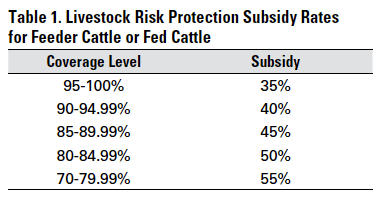Strategic Partnerships for Resilience: Bagley Risk Management
Strategic Partnerships for Resilience: Bagley Risk Management
Blog Article
Recognizing Livestock Risk Defense (LRP) Insurance Policy: A Comprehensive Guide
Browsing the world of animals risk security (LRP) insurance policy can be a complex venture for many in the agricultural market. From just how LRP insurance works to the different insurance coverage alternatives available, there is much to uncover in this extensive overview that might potentially shape the means animals producers approach threat management in their companies.

How LRP Insurance Coverage Works
Periodically, comprehending the mechanics of Animals Risk Defense (LRP) insurance policy can be complex, yet damaging down how it functions can offer clarity for farmers and breeders. LRP insurance coverage is a threat monitoring device developed to safeguard livestock producers versus unanticipated rate decreases. It's important to note that LRP insurance coverage is not a profits warranty; rather, it focuses entirely on cost threat defense.
Qualification and Coverage Options

When it comes to protection alternatives, LRP insurance coverage uses manufacturers the adaptability to pick the coverage level, protection period, and endorsements that finest suit their risk management needs. Insurance coverage levels usually vary from 70% to 100% of the expected finishing value of the insured animals. Producers can also select insurance coverage periods that straighten with their production cycle, whether they are guaranteeing feeder livestock, fed livestock, swine, or lamb. Endorsements such as rate danger protection can better tailor insurance coverage to safeguard against negative market variations. By recognizing the qualification criteria and insurance coverage choices available, animals producers can make enlightened choices to handle threat effectively.
Pros and Disadvantages of LRP Insurance Coverage
When reviewing Animals Risk Defense (LRP) insurance, it is essential for livestock producers to weigh the benefits and disadvantages integral in this danger administration device.

One of the primary advantages of LRP insurance is its ability to give security versus a decline in livestock prices. Additionally, LRP insurance policy provides a level of flexibility, allowing manufacturers to tailor protection degrees and policy periods to match their particular needs.
Nonetheless, there are likewise some disadvantages to take into consideration. One constraint of LRP insurance policy is that it does not secure versus all kinds of dangers, such as disease episodes or natural catastrophes. Costs can often be pricey, especially for producers with large livestock herds. It is important for producers to you can try here very carefully evaluate their specific threat exposure and economic scenario to establish if LRP insurance coverage is the best danger management device for their procedure.
Recognizing LRP Insurance Policy Premiums

Tips for Making The Most Of LRP Perks
Maximizing the benefits of Animals Risk Protection (LRP) insurance requires strategic planning and positive danger monitoring - Bagley Risk Management. To make the most of your LRP protection, think about the complying with pointers:
Frequently Examine Market Problems: Keep educated concerning market trends and price changes in the livestock market. By keeping track of these aspects, you can make informed decisions regarding when to purchase LRP coverage to secure versus possible losses.
Establish Realistic Insurance Coverage Degrees: When picking coverage degrees, consider your manufacturing prices, market worth of animals, and possible threats - Bagley Risk Management. Establishing realistic coverage levels guarantees that you are adequately safeguarded without overpaying for unneeded insurance
Expand Your Coverage: Rather than depending solely on LRP insurance, consider expanding your danger management methods. Combining LRP with other danger management devices such as futures agreements or options can offer extensive coverage versus market uncertainties.
Review and Readjust Protection Consistently: As market problems alter, periodically evaluate your LRP protection to ensure it aligns with your current threat exposure. Changing coverage degrees and timing of purchases can assist enhance your risk defense strategy. By complying with these suggestions, you can maximize the advantages of LRP insurance and guard your livestock procedure against unpredicted threats.
Final Thought
Finally, livestock risk protection (LRP) insurance policy is a useful tool for farmers to take care of the monetary risks connected with their livestock procedures. By comprehending just how LRP works, qualification and protection alternatives, as well as the benefits and drawbacks of this insurance coverage, farmers can make informed decisions to shield their source of incomes. By meticulously taking into consideration LRP premiums and implementing strategies to make best use of advantages, farmers can reduce prospective losses and make sure the sustainability of their procedures.
Animals manufacturers interested in obtaining Livestock Danger Security (LRP) insurance coverage can Find Out More explore a variety of qualification requirements and insurance coverage options tailored to their particular livestock operations.When it comes to protection choices, LRP insurance coverage uses manufacturers the adaptability to choose the coverage level, coverage period, and recommendations that ideal suit their danger administration requirements.To realize the complexities of Livestock Threat Protection (LRP) insurance policy completely, recognizing the elements affecting LRP insurance coverage premiums is essential. LRP insurance coverage costs are identified by various aspects, including the coverage level selected, the expected rate of livestock at the end of the coverage duration, the type of livestock being guaranteed, and the length of the coverage duration.Evaluation and Change Coverage On a regular basis: As market conditions alter, periodically review your LRP insurance coverage to guarantee it straightens with your present danger exposure.
Report this page